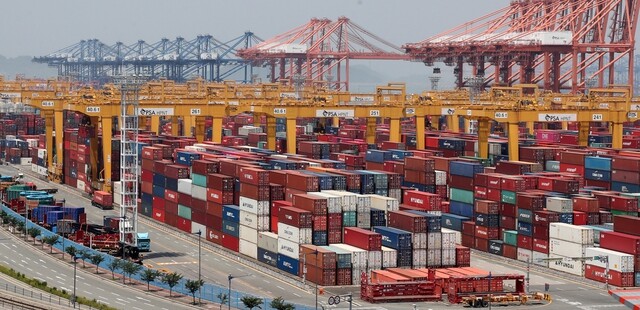hankyoreh
Links to other country sites 다른 나라 사이트 링크
[Editorial] Account deficit indicates needs to diversity S. Korea’s economic structure

Figures calculated for South Korea by the Bank of Korea (BOK) and published on June 5 showed a deficit in the current account balance. Representing the first deficit in the seven years since April 2012, the numbers are likely to trigger fears among economic actors. Compounding the anxiety are the economic growth rate, which showed minus growth in the first quarter, and the intensifying US-China trade war, which could have catastrophic consequences for the South Korean economy. While we should not be overreacting, recent developments suggest it is time for the government to manage the economy with a sense of urgency.
The chief factor behind the US$660 million current account deficit in April was a large (US$4.99 billion) deficit in the dividend balance. Despite a surplus of US$5.67 billion in commodity exports and imports, large deficits in the balance of dividend income as well as travel and other services (US$1.43 billion) shifted the overall balance into the red. Citing the dividend balance as the main cause of the deficit, BOK viewed it as a temporary phenomenon and predicted the surplus would return in May.
Indeed, the month of April typically sees large amounts of dividend payouts by corporations settling their accounts from the previous December, while transfers of dividends received by foreign investors result in significant dollar-denominated outflows. This explains the deficits recorded in the dividend balances for April 2017 (US$5.12 billion) and April 2018 (US$6.36 billion). The major influence from seasonal factors suggests this is not a situation that calls for overinterpretation or overreacting – even if news of the current account deficit did result in the won-to-dollar exchange rate dipping by 4.2 on the Seoul foreign exchange market that day.
But we also can’t afford to simply rest easy. Trends in exports have not been stable. May exports (customs clearance) totaled U$45.91 billion, down 9.4% from the same month in 2018. It was the sixth straight month of decline, and the decrease was bigger than in April (-2.0%). This is the result of a persistent slump in semiconductors, which account for over 20% of all South Korean exports, and the negative effects of the intensifying US-China trade war. Judging from the way the trade war is currently unfolding, this trend in exports appears likely to continue going forward. It’s a worrying development.
Together with foreign currency reserves, the current account balance is considered one of the leading indicators of a country’s economic fundamentals. It’s all the more important a metric for an economy like ours, with its heavy dependence on foreign markets. A mounting current account deficit was also one of the factors behind the foreign exchange crisis in 1997. For now, we should be closely monitoring foreign exchange market trends to prepare for eventualities, while focusing on intermediate- to long-term measures to transform our economic constitution by diversifying its structure, which is heavily skewed right now in terms of export products, markets, and actors.
Please direct comments or questions to [english@hani.co.kr]

Editorial・opinion
![[Guest essay] Maybe Korea’s rapid population decline is an opportunity, not a crisis [Guest essay] Maybe Korea’s rapid population decline is an opportunity, not a crisis](https://flexible.img.hani.co.kr/flexible/normal/500/300/imgdb/original/2024/0430/9417144634983596.jpg) [Guest essay] Maybe Korea’s rapid population decline is an opportunity, not a crisis
[Guest essay] Maybe Korea’s rapid population decline is an opportunity, not a crisis![[Column] Can Yoon steer diplomacy with Russia, China back on track? [Column] Can Yoon steer diplomacy with Russia, China back on track?](https://flexible.img.hani.co.kr/flexible/normal/500/300/imgdb/original/2024/0430/1617144616798244.jpg) [Column] Can Yoon steer diplomacy with Russia, China back on track?
[Column] Can Yoon steer diplomacy with Russia, China back on track?- [Column] Season 2 of special prosecutor probe may be coming to Korea soon
- [Column] Park Geun-hye déjà vu in Yoon Suk-yeol
- [Editorial] New weight of N. Korea’s nuclear threats makes dialogue all the more urgent
- [Guest essay] The real reason Korea’s new right wants to dub Rhee a founding father
- [Column] ‘Choson’: Is it time we start referring to N. Korea in its own terms?
- [Editorial] Japan’s rewriting of history with Korea has gone too far
- [Column] The president’s questionable capacity for dialogue
- [Column] Are chaebol firms just pizza pies for families to divvy up as they please?
Most viewed articles
- 1‘We must say no’: Seoul defense chief on Korean, USFK involvement in hypothetical Taiwan crisis
- 2After election rout, Yoon’s left with 3 choices for dealing with the opposition
- 3Why Kim Jong-un is scrapping the term ‘Day of the Sun’ and toning down fanfare for predecessors
- 4Two factors that’ll decide if Korea’s economy keeps on its upward trend
- 5Noting shared ‘values,’ Korea hints at passport-free travel with Japan
- 6AI is catching up with humans at a ‘shocking’ rate
- 7[Correspondent’s column] The US and the end of Japanese pacifism
- 8A week of protests lays bare many inherent vices of Korean health care system
- 9[Editorial] As it bolsters its alliance with US, Japan must be accountable for past
- 10[Editorial] Japan’s rewriting of history with Korea has gone too far